David R. Mortensen
ZIPA: A family of efficient models for multilingual phone recognition
May 29, 2025Abstract:We present ZIPA, a family of efficient speech models that advances the state-of-the-art performance of crosslinguistic phone recognition. We first curated IPAPack++, a large-scale multilingual speech corpus with 17,132 hours of normalized phone transcriptions and a novel evaluation set capturing unseen languages and sociophonetic variation. With the large-scale training data, ZIPA, including transducer (ZIPA-T) and CTC-based (ZIPA-CR) variants, leverage the efficient Zipformer backbones and outperform existing phone recognition systems with much fewer parameters. Further scaling via noisy student training on 11,000 hours of pseudo-labeled multilingual data yields further improvement. While ZIPA achieves strong performance on benchmarks, error analysis reveals persistent limitations in modeling sociophonetic diversity, underscoring challenges for future research.
Towards Inclusive ASR: Investigating Voice Conversion for Dysarthric Speech Recognition in Low-Resource Languages
May 20, 2025Abstract:Automatic speech recognition (ASR) for dysarthric speech remains challenging due to data scarcity, particularly in non-English languages. To address this, we fine-tune a voice conversion model on English dysarthric speech (UASpeech) to encode both speaker characteristics and prosodic distortions, then apply it to convert healthy non-English speech (FLEURS) into non-English dysarthric-like speech. The generated data is then used to fine-tune a multilingual ASR model, Massively Multilingual Speech (MMS), for improved dysarthric speech recognition. Evaluation on PC-GITA (Spanish), EasyCall (Italian), and SSNCE (Tamil) demonstrates that VC with both speaker and prosody conversion significantly outperforms the off-the-shelf MMS performance and conventional augmentation techniques such as speed and tempo perturbation. Objective and subjective analyses of the generated data further confirm that the generated speech simulates dysarthric characteristics.
Cross-Lingual IPA Contrastive Learning for Zero-Shot NER
Mar 10, 2025Abstract:Existing approaches to zero-shot Named Entity Recognition (NER) for low-resource languages have primarily relied on machine translation, whereas more recent methods have shifted focus to phonemic representation. Building upon this, we investigate how reducing the phonemic representation gap in IPA transcription between languages with similar phonetic characteristics enables models trained on high-resource languages to perform effectively on low-resource languages. In this work, we propose CONtrastive Learning with IPA (CONLIPA) dataset containing 10 English and high resource languages IPA pairs from 10 frequently used language families. We also propose a cross-lingual IPA Contrastive learning method (IPAC) using the CONLIPA dataset. Furthermore, our proposed dataset and methodology demonstrate a substantial average gain when compared to the best performing baseline.
DialUp! Modeling the Language Continuum by Adapting Models to Dialects and Dialects to Models
Jan 27, 2025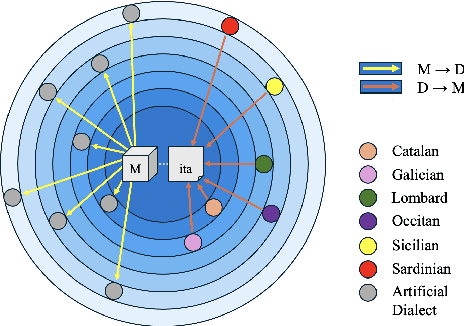


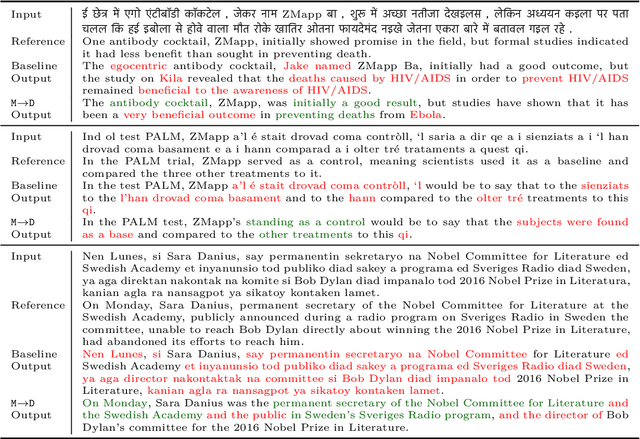
Abstract:Most of the world's languages and dialects are low-resource, and lack support in mainstream machine translation (MT) models. However, many of them have a closely-related high-resource language (HRL) neighbor, and differ in linguistically regular ways from it. This underscores the importance of model robustness to dialectical variation and cross-lingual generalization to the HRL dialect continuum. We present DialUp, consisting of a training-time technique for adapting a pretrained model to dialectical data (M->D), and an inference-time intervention adapting dialectical data to the model expertise (D->M). M->D induces model robustness to potentially unseen and unknown dialects by exposure to synthetic data exemplifying linguistic mechanisms of dialectical variation, whereas D->M treats dialectical divergence for known target dialects. These methods show considerable performance gains for several dialects from four language families, and modest gains for two other language families. We also conduct feature and error analyses, which show that language varieties with low baseline MT performance are more likely to benefit from these approaches.
Self-supervised Speech Representations Still Struggle with African American Vernacular English
Aug 26, 2024

Abstract:Underperformance of ASR systems for speakers of African American Vernacular English (AAVE) and other marginalized language varieties is a well-documented phenomenon, and one that reinforces the stigmatization of these varieties. We investigate whether or not the recent wave of Self-Supervised Learning (SSL) speech models can close the gap in ASR performance between AAVE and Mainstream American English (MAE). We evaluate four SSL models (wav2vec 2.0, HuBERT, WavLM, and XLS-R) on zero-shot Automatic Speech Recognition (ASR) for these two varieties and find that these models perpetuate the bias in performance against AAVE. Additionally, the models have higher word error rates on utterances with more phonological and morphosyntactic features of AAVE. Despite the success of SSL speech models in improving ASR for low resource varieties, SSL pre-training alone may not bridge the gap between AAVE and MAE. Our code is publicly available at https://github.com/cmu-llab/s3m-aave.
Carrot and Stick: Inducing Self-Motivation with Positive & Negative Feedback
Jun 24, 2024Abstract:Positive thinking is thought to be an important component of self-motivation in various practical fields such as education and the workplace. Previous work, including sentiment transfer and positive reframing, has focused on the positive side of language. However, self-motivation that drives people to reach their goals has not yet been studied from a computational perspective. Moreover, negative feedback has not yet been explored, even though positive and negative feedback are both necessary to grow self-motivation. To facilitate self-motivation, we propose CArrot and STICk (CASTIC) dataset, consisting of 12,590 sentences with 5 different strategies for enhancing self-motivation. Our data and code are publicly available at here.
Zero-Shot Cross-Lingual NER Using Phonemic Representations for Low-Resource Languages
Jun 23, 2024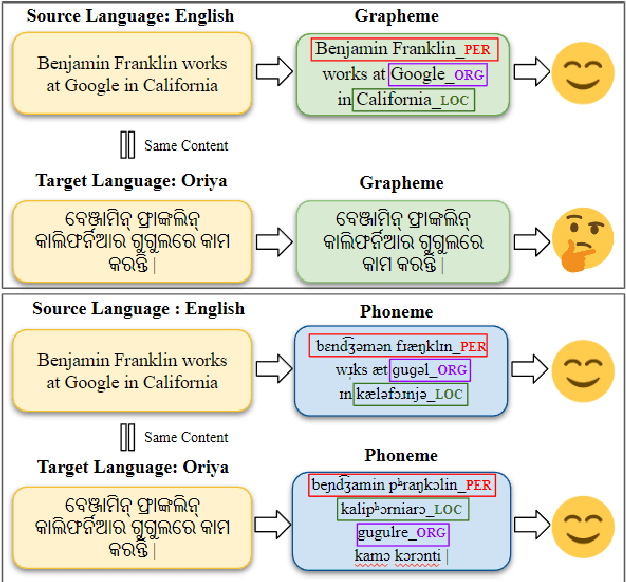



Abstract:Existing zero-shot cross-lingual NER approaches require substantial prior knowledge of the target language, which is impractical for low-resource languages. In this paper, we propose a novel approach to NER using phonemic representation based on the International Phonetic Alphabet (IPA) to bridge the gap between representations of different languages. Our experiments show that our method significantly outperforms baseline models in extremely low-resource languages, with the highest average F-1 score (46.38%) and lowest standard deviation (12.67), particularly demonstrating its robustness with non-Latin scripts.
Semisupervised Neural Proto-Language Reconstruction
Jun 09, 2024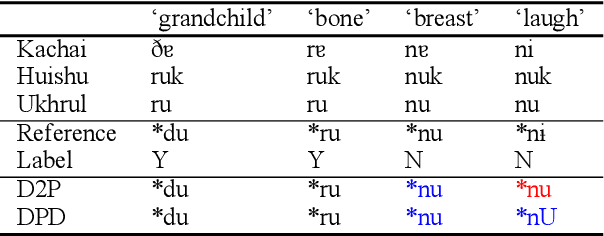
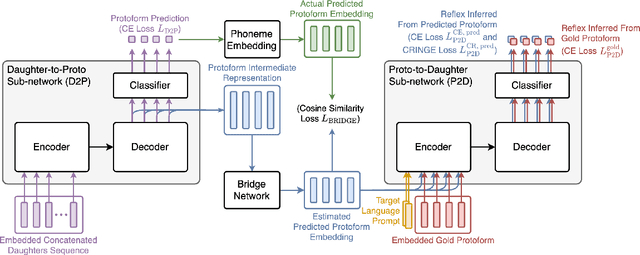

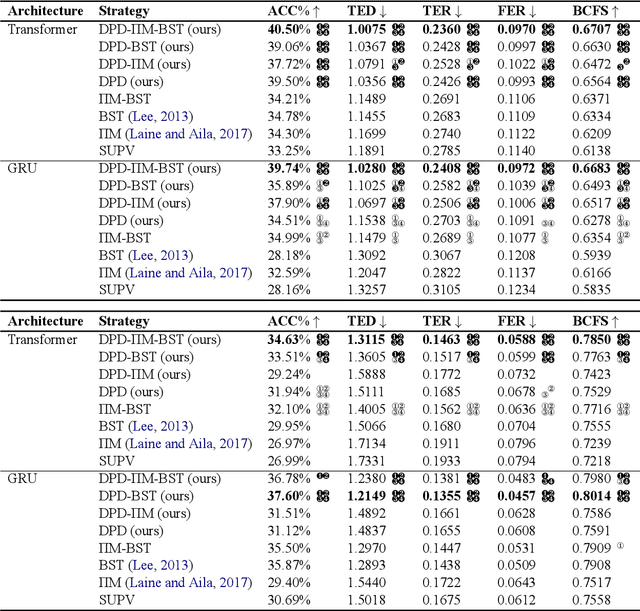
Abstract:Existing work implementing comparative reconstruction of ancestral languages (proto-languages) has usually required full supervision. However, historical reconstruction models are only of practical value if they can be trained with a limited amount of labeled data. We propose a semisupervised historical reconstruction task in which the model is trained on only a small amount of labeled data (cognate sets with proto-forms) and a large amount of unlabeled data (cognate sets without proto-forms). We propose a neural architecture for comparative reconstruction (DPD-BiReconstructor) incorporating an essential insight from linguists' comparative method: that reconstructed words should not only be reconstructable from their daughter words, but also deterministically transformable back into their daughter words. We show that this architecture is able to leverage unlabeled cognate sets to outperform strong semisupervised baselines on this novel task.
Neural Proto-Language Reconstruction
Apr 24, 2024



Abstract:Proto-form reconstruction has been a painstaking process for linguists. Recently, computational models such as RNN and Transformers have been proposed to automate this process. We take three different approaches to improve upon previous methods, including data augmentation to recover missing reflexes, adding a VAE structure to the Transformer model for proto-to-language prediction, and using a neural machine translation model for the reconstruction task. We find that with the additional VAE structure, the Transformer model has a better performance on the WikiHan dataset, and the data augmentation step stabilizes the training.
Improved Neural Protoform Reconstruction via Reflex Prediction
Mar 27, 2024



Abstract:Protolanguage reconstruction is central to historical linguistics. The comparative method, one of the most influential theoretical and methodological frameworks in the history of the language sciences, allows linguists to infer protoforms (reconstructed ancestral words) from their reflexes (related modern words) based on the assumption of regular sound change. Not surprisingly, numerous computational linguists have attempted to operationalize comparative reconstruction through various computational models, the most successful of which have been supervised encoder-decoder models, which treat the problem of predicting protoforms given sets of reflexes as a sequence-to-sequence problem. We argue that this framework ignores one of the most important aspects of the comparative method: not only should protoforms be inferable from cognate sets (sets of related reflexes) but the reflexes should also be inferable from the protoforms. Leveraging another line of research -- reflex prediction -- we propose a system in which candidate protoforms from a reconstruction model are reranked by a reflex prediction model. We show that this more complete implementation of the comparative method allows us to surpass state-of-the-art protoform reconstruction methods on three of four Chinese and Romance datasets.
 Add to Chrome
Add to Chrome Add to Firefox
Add to Firefox Add to Edge
Add to Edge